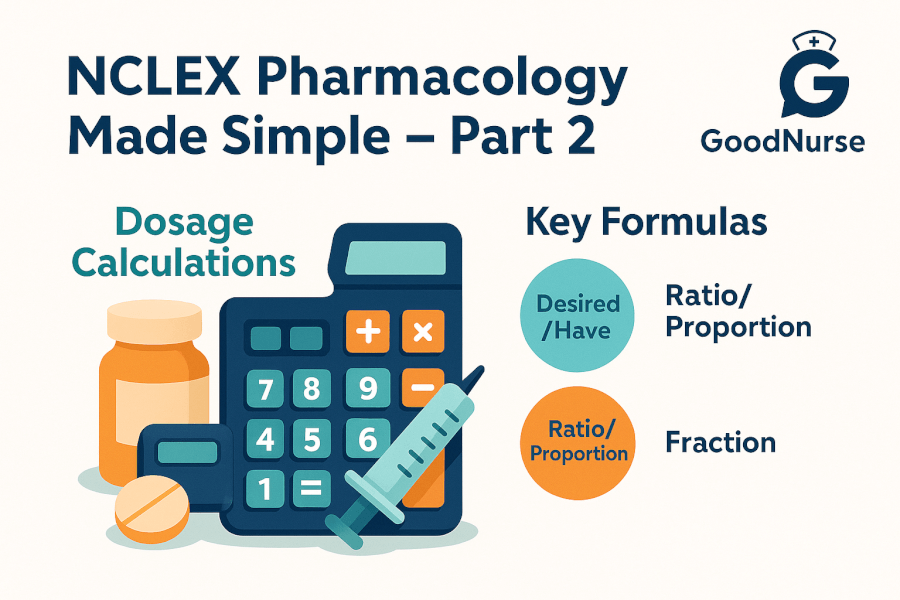NCLEX Pharmacology Made Simple: Your Essential Review of Drugs, Calculations, and Key Concepts (Part 2 of 3)
Missed Part 1? Catch up here → NCLEX Pharmacology Made Simple — Part 1
III. Mastering NCLEX Drug Dosage Calculations
Accurate dosage calculation is a core nursing skill and a high‑stakes NCLEX topic. Before you crunch any numbers, review the medication‑administration rights; afterwards, sanity‑check that the dose makes sense for the drug and patient.
Essential Formulas and Methods
1. Standard Formula (Desired ÷ Have)
(Desired Dose ÷ Dose on Hand) × Vehicle = Amount to Administer
Example – Order: Amoxicillin 250 mg. Supply: 125 mg / 5 mL
(250 mg ÷ 125 mg) × 5 mL = 10 mL
2. Ratio‑and‑Proportion Method
Dose on Hand : Vehicle :: Desired Dose : x → x = (Desired × Vehicle) ÷ Have
Example – 125 mg : 5 mL :: 250 mg : x mL → x = 10 mL
3. Fractional‑Equation Method
Vehicle ÷ Have = Amount to Administer ÷ Desired
Table 1 – Common Calculation Formulas
| Method | Formula | Quick Use‑Case |
|---|---|---|
| Standard | (D ÷ H) × V = x |
Straightforward tablet/liquid problems |
| Ratio & Proportion | H : V :: D : x |
When you like “cross‑multiplying” |
| Fractional | V ÷ H = x ÷ D |
Same logic as R & P in fraction form |
Key Terminology
| Term | What it Means |
|---|---|
| Desired Dose (D) | The amount ordered |
| Dose on Hand (H) | Strength supplied |
| Vehicle / Volume (V) | Form in which the drug is supplied (tablet, mL, etc.) |
| Amount to Administer (x) | Your calculated dose |
🥇Voted #1 Nursing Study Tool.
Personalized AI Tutor + Instant Answers to All Your Questions. 100% Money Back Guarantee!
Measurement Systems and Conversions — The Nurse’s Math Toolkit
Metric (standard)
- 1 kg = 1000 g • 1 g = 1000 mg • 1 mg = 1000 mcg
- 1 L = 1000 mL
Household (still tested)
- 1 tsp ≈ 5 mL • 1 Tbsp ≈ 15 mL • 1 fl oz ≈ 30 mL • 1 cup ≈ 240 mL
Other units
- Units (U): insulin, heparin — write “Units,” never “U”
- mEq: electrolytes (e.g., KCl)
Breeze through the toughest drug questions.
Review the
10 Pharmacology Concepts Every Nursing Student Must Know (2025 Edition)
—a quick-hit guide to the drug principles the NCLEX loves to test.
Table 2 – Essential Metric & Household Conversions
| Measurement | Metric | Common Equivalent |
|---|---|---|
| Weight | 1 kg | 2.2 lb |
| 1 g | 1000 mg | |
| 1 mg | 1000 mcg | |
| Volume | 1 L | 1000 mL |
| 5 mL | 1 tsp | |
| 15 mL | 1 Tbsp | |
| 30 mL | 1 fl oz / 2 Tbsp | |
| 240 mL | 1 cup / 8 fl oz | |
| Apothecary | 60–65 mg | ≈ 1 grain |
| 300–325 mg | ≈ 5 grains |
Step‑by‑Step Examples
| Scenario | Order | Supply | Work | Answer |
|---|---|---|---|---|
| Tablets | Furosemide 40 mg | 20 mg tablet | (40 ÷ 20) × 1 |
2 tabs |
| Oral liquid | Acetaminophen 320 mg | 160 mg/5 mL | 160:5 :: 320:x |
10 mL |
| Injection | Morphine 4 mg IM | 10 mg/mL vial | (4 ÷ 10) × 1 |
0.4 mL |
IV flow‑rate, drops‑per‑minute, and weight‑based pediatrics will get their own deep‑dive article.
Top Tips to Avoid Calculation Errors
- Read the order carefully
- Double‑check your math
- Convert units before you start
- Use the NCLEX on‑screen calculator
- No trailing zeros (5 mg, not 5.0 mg)
- Always leading zeros (0.5 mg, not .5 mg)
- Round only as instructed
- Reality‑check: does the dose look reasonable?
IV. High‑Yield NCLEX Drug Classifications: Your Essential Review
Focus on prototypes, class suffixes/prefixes, mechanisms, key indications, major side effects, and must‑know nursing alerts. Prioritise generic names.
A. Cardiovascular Drugs
Cardiovascular medications are among the most frequently tested on the NCLEX.
For a deeper dive, check out our NCLEX Cardiovascular Drugs In‑Depth guide covering ACEIs, ARBs, beta‑blockers, CCBs, diuretics, digoxin, and amiodarone.
1. ACE Inhibitors (-pril)
| Key Points | — |
|---|---|
| MOA | Blocks Ang I → Ang II conversion → vasodilation + ↓ aldosterone |
| Uses | HTN, HF, post‑MI, diabetic nephropathy |
| Side‑Effects | Angioedema • Dry cough • ↑ K⁺ • First‑dose hypotension |
| Nursing Alerts | Monitor BP & K⁺; watch for angioedema; contraindicated in pregnancy |
| Mnemonic | A C E → Angioedema • Cough • Elevated K⁺ |
2. Beta Blockers (-olol)
- Selective (β₁): metoprolol, atenolol
-
Non‑selective (β₁/β₂): propranolol → may cause bronchospasm
NCLEX Alert: Check apical HR (hold < 60) and BP before giving; taper—don’t stop abruptly.
Mnemonic: Bradycardia • Breathing problems • Blood‑pressure down • Blood sugar masked
3. Diuretics
| Class | Prototype | Key NCLEX Notes |
|---|---|---|
| Loop | furosemide | Monitor K⁺ & fluid status; IV push slowly (ototoxicity) |
| Thiazide | HCTZ | Risk hypokalemia, hyper‑calcemia/glycemia/uricemia |
| Potassium‑Sparing | spironolactone | Hyper‑K⁺ risk; endocrine effects (gynecomastia) |
4. Anticoagulants
| Drug | Monitor | Antidote |
|---|---|---|
| Warfarin | INR 2‑3 | Vitamin K |
| Heparin (IV) | aPTT 1.5‑2.5× control | Protamine sulfate |
| Enoxaparin (SQ) | Anti‑Xa (in special cases) | Protamine (partial) |
Implement bleeding precautions and keep vitamin K intake consistent with warfarin.
B. Antibiotics – Quick NCLEX Reminders
| Class | Prototype / Suffix | NCLEX High‑Alert |
|---|---|---|
| Penicillins | amoxicillin (‑cillin) | Allergic reactions; cross‑sensitivity with cephalosporins |
| Cephalosporins | ceftriaxone (cef‑/ceph‑) | Similar allergy profile; monitor kidneys |
| Aminoglycosides | gentamicin (‑mycin) | Peak & trough; nephro‑ & ototoxicity – “Can’t hear, can’t pee” |
| Fluoroquinolones | ciprofloxacin (‑floxacin) | Tendon rupture; photosensitivity; avoid antacids/dairy |
| Vancomycin | — | Infuse slowly to avoid Red‑Man Syndrome; monitor trough |
Looking Ahead
Part 3 will dive into medication safety essentials and smart study strategies to cement your pharmacology knowledge for the NCLEX.
You’ve just finished Part 2 of our three‑part NCLEX pharmacology roadmap.
Jump back to the foundations or power ahead to the finale:





